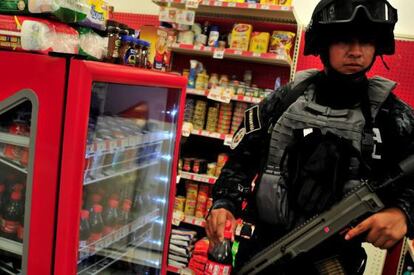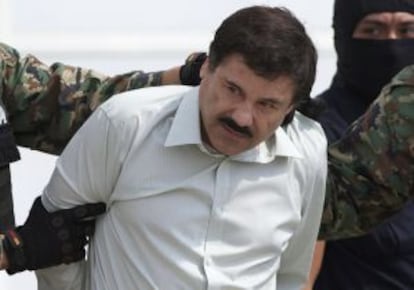Mexico’s new generation of cartels
Gangs such as Guerreros Unidos are smaller and rely less on drugs to make money


Compact, ultraviolent and with a strong territorial presence: such are the new criminal organizations born out of the open warfare waged between Mexican authorities and the drug cartels for the last eight years.
Gone are the days of drug lords such as El Chapo Guzmán, whose networks operated nationwide and who acted as arbiters in territorial disputes and had privileged connections in the world’s capitals.
Instead, what predominates now are small, loosely structured gangs that operate in reduced territories and have the ability to multiply in extremely hostile environments.
In this fragmented universe, under constant pressure from rival clans and military action, these viral groups have abandoned drugs as their main source of income and turned instead to extortion, theft and abductions, three crimes that bring financial profits and territorial control as a reward, but which require constant acts of violence to keep the system running, say experts.
A case in point is Guerreros Unidos, the cartel accused of murdering 43 students from a teachers’ college who went missing in Iguala (Guerrero state) in late September.
“The new gangs are more local and predatory in nature,” says security analyst Alejandro Hope. “In the case of Guerrero, this trend has reached an apex because of the institutional weakness in the territory. Nothing has stopped them, and they have taken control of municipalities such as Iguala. Guerreros Unidos is the clearest example. They are not very sophisticated, they operate locally, and they sell drugs on the international market through intermediaries. They are the children of fragmentation.”
Guerreros Unidos, which means United Warriors in Spanish but also plays with the name of its home state, was born out of the ashes of the empire once headed by notorious kingpin Arturo Beltrán Leyva, known as “The Boss of Bosses” and a former ally of El Chapo Guzmán. Leyva was shot down by marines on December 16, 2009.
His fall left a power vacuum in a vast territory that included broad swathes of the Pacific area and central Mexico. His cartel broke up and made way for multiple criminal groups (there are 10 groups operating in Guerrero state alone, according to intelligence sources). These gangs began fighting over the spoils, and one of them quickly stood out among the rest.
Its genesis was a unit of particularly fierce gunmen that Beltrán Leyva created in 2005 to keep control over Guerrero, Mexico’s poorest and most violent state, and to confront rival cartels. The task of creating the elite group fell to two brothers who had proven their ability transferring drug shipments from Colombia and Venezuela to Acapulco. Their names were Alberto and Mario Pineda Villa, and their sister was married to Iguala’s mayor.

The brothers created a unit for Beltrán Leyva called Los Pelones, and the group eventually became the backbone of Guerreros Unidos. In 2009, the Pineda Villa brothers were murdered, allegedly for attempting to betray the Boss of Bosses. When Beltrán Leyva was himself shot down months later, this branch of the cartel was taken over by Cleotilde Toribio Rentería and later by a fearsome killer, Mario Casarrubias Salgado, aka Sapo Guapo (Handsome Toad).
Under Sapo Guapo, the Guerrero gang grew exponentially. It mutilated, tortured and assassinated without scruple, and managed to infiltrate police and political circles in Guerrero, where fee payments were extended to previously unknown limits.
This expansion came hand in hand with a ruthless battle against rival gangs, especially Los Rojos, whose wounded leader Crisóforo Rogelio Maldonado Jiménez was finished off by a gunman disguised as a doctor inside an intensive care ward in Mexico City on December 14, 2012.
The assassination triggered a brutal war that left over 70 dead in Mexico state alone. The bloodbath put authorities on alert out of fear that the violence might reach the nation’s capital.
Sapo Guapo, 33, was captured on April 29 but, as usual, was quickly replaced. His position was filled by his brother Sidronio, who apparently took the protesting students in Iguala to be members of the rival Los Rojos gang and ordered their extermination “to defend the territory.”
Sidronio was arrested by police two weeks ago. By now, another hitman has probably taken his place and is already plotting the next vendetta.
Tu suscripción se está usando en otro dispositivo
¿Quieres añadir otro usuario a tu suscripción?
Si continúas leyendo en este dispositivo, no se podrá leer en el otro.
FlechaTu suscripción se está usando en otro dispositivo y solo puedes acceder a EL PAÍS desde un dispositivo a la vez.
Si quieres compartir tu cuenta, cambia tu suscripción a la modalidad Premium, así podrás añadir otro usuario. Cada uno accederá con su propia cuenta de email, lo que os permitirá personalizar vuestra experiencia en EL PAÍS.
En el caso de no saber quién está usando tu cuenta, te recomendamos cambiar tu contraseña aquí.
Si decides continuar compartiendo tu cuenta, este mensaje se mostrará en tu dispositivo y en el de la otra persona que está usando tu cuenta de forma indefinida, afectando a tu experiencia de lectura. Puedes consultar aquí los términos y condiciones de la suscripción digital.







































